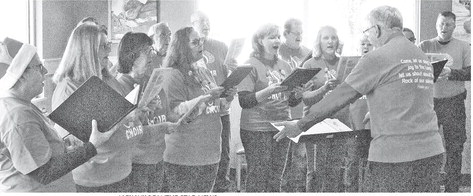Take advantage of frost season with frost seeding


Agriculture is an enterprise that is determined by innovation, yet it survives on traditions. “What Grandpa used to do,” “They used to do this back in the day,” and practices that occurred “before cell phones,” come into the conversation from time to time, for better or for worse. Some of these timeless approaches can be obvious, as well as “unconventional.” As north-central Wisconsin marches its way through this weather-confused winter and onto spring, a certain practice has been put forward by farmers more than usual that is a trick from the old-dogs of agriculture frost seeding.
Frost seeding is surface applying (broadcast) seed in late winter/early spring onto frozen ground on the verge of spring thaw. The most popular application is frost seeding into an existing hay field. This bolsters biomass and maintains forage quality and yield, in case a pasture or hayfield becomes less productive due to winter-kill, disease, or heavy traffic (livestock or tractors). The process of the soil surface freezing and thawing (repeat) incorporates the seed into the ground and helps establish new seedlings into a field quickly and easily. Well, kind of easily. If the seed is broadcasted in snow and the snow melts too fast, the seed will be washed away before it even reaches the ground. Or if there is a lot of debris covering the field surface, less seeds make soil contact, making less uniform stands. Or you can miss the frozen conditions in the early morning and the field soon becomes too soft to apply on. The window tends to be tight and way too early in the morning.
But this year is different. With well above average temperatures melting any remnants of snow (and woefully low snowfall this winter), followed by conveniently below freezing temperatures at night have presented the best conditions for frost seeding, perhaps ever. If you were ever going to try it, this week is the time to do it. The other idea behind frost seeding is getting the species you want to grow to have low competition against established plants so they grow at the same time. And when you think about it, you are mimicking a process seen in nature where plants are littering seeds onto the ground late in the year to green up in the spring. So, if mother nature isn’t going to give us snow this season, we might as well take a page out of her playbook to get some more biomass in our hay fields and food plots. The most popular species are clovers with their hard seed hulls and cold germ capabilities. They are a species built for tough conditions. The seed size also gives clovers a big advantage. With red clovers ranging from approximately 250,000 to 500,000 seeds per pound, you can use a low seeding rate to get a lot of plants out in the field. When selecting a clover, consider your intentions and where you are applying. If you want to build up a food plot with a perennial, pick Ladino White clover or Alsike. If you are thickening up a pasture or hayfield, consider Medium or an improved red clover. If you want to have something thick or fast, give Balansa a try. Want to jazz up your lawn? Use a combination of red and white clovers with some lawn seed. Grasses can also be used but have varying success because grass seeds lack a hard shell and are more susceptible to the elements. With that being said orchard grass, timothy, and annual ryegrass/Italian ryegrass have shown previous success more than other grasses.
Application need not be complicated. Just the use of a mechanism that broadcasts/ spreads/flings the seed out. A tractor or ATV mount cone spreader works great and is generally reasonable in price/widely sold, or accessible through someone who owns one (a neighbor or friend of a friend). You can go with the old standard for a hand-spreader driven by human endurance. Seeding rates can stay on the low side, 4-8 lbs/acre.
Most of the calls I have received have been for forage systems for hay and grazing but you don’t need a farm or livestock to frost seed. This is great for outdoorsmen with a tight schedule looking to seed down a trail or thicken up a food plot. Maybe you are an urban weekend warrior and you have a roughed-up lawn. Get some clover mixed with lawn seed and watch the yard green up in mid-spring. Or maybe you don’t have a green thumb and you have a patch of ground by the house or office that could use some life. Give pollinators and the grandkids something to enjoy with frost seeded clovers.
The Soil
Sound-O
ff



